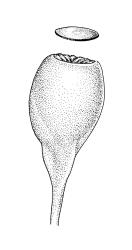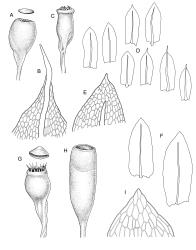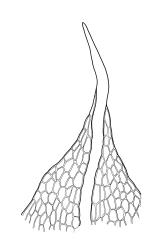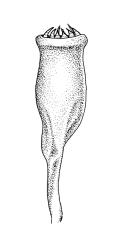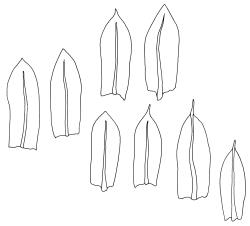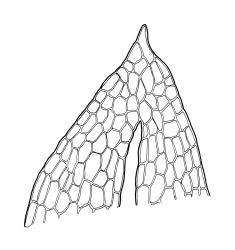- ≡ Entosthodon gracilis Hook.f. & Wilson in Wilson, Bot. Antarct. Voy. II (Fl. Nov.-Zel.) Part II, 91 (1854)
- ≡ Funaria gracilis (Hook.f. & Wilson) Broth., Nat. Pflanzenfam. [Engler & Prantl] 1(3), 524 (1903)
- = Funaria cuspidata Hook.f. & Wilson in Wilson, Bot. Antarct. Voy. II (Fl. Nov.-Zel.) Part II, 91 (1854)
Plants yellow- or brown-green. Stems red-brown, 2–5 mm, branching once by subperigonial innovation, beset with red-brown rhizoids. Leaves erect-spreading when moist, oblong-obovate, tapered in upper ⅓ to an acute, obtuse, or slender and aristate or cuspidate apex, (1.3–)1.5–2.1 × 0.6–0.8 mm, concave, entire; upper laminal cells (24–)33–69 × 15–18 µm; apical cell variable in length, 60–110(–165) µm; alar cells few, moderately inflated. Costa highly variable in length (often variable within a population or even a single plant), failing below leaf apices, percurrent to long excurrent as a cusp, c. 36–45 µm wide near base. Axillary hairs present.
Autoicous. Perigonia and perichaetia as per genus. Setae slender, 9–22 mm, weakly dextrorse throughout, pale red-brown, weakly hygroscopic; capsules erect and symmetric, obovoid-cylindric or obovoid, 1.5–1.8(–2.0) mm with a neck c. ⅓ the capsule length, strongly constricted below mouth when dry; mouth transverse, equal to the capsule diameter; exothecial cells elongate, in surface view with obscure lumina, in cross-section with anticlinal walls strongly cuneate, c. 6–8 rows oblate at mouth; operculum plano-convex. Peristome double; exostome teeth variably developed and usually ± irregular in outline and with sinuose margins, striate, tapered to an acute or irregular and often ± perforate apex; endostome variable, rudimentary to c. ⅓ height of teeth. Spores 32–39(–45) µm, finely lirate, lacking a trilete scar.
Wilson 1854, pl. 86, fig. 3 (as Funaria cuspidata); fig. 7 (as Entosthodon gracilis); Catcheside 1980, figs 123–125 (as Funaria gracilis, F. bullata, and F. cuspidata); Meagher & Fuhrer 2003, p. 153.
NI: N Auckland (numerous localities), S Auckland (Coromandel Peninsula, Waerenga, Cambridge, Ātiamuri, Waiotapu Valley), Hawke’s Bay (Wairoa, Māhia Peninsula, near Whakamahi Lagoon); SI: Marlborough (Kenepuru), Canterbury (Black Range), Otago (Trotters Gorge).
Australasian. Tasmania*, mainland Australia*, New Caledonia*.
On finely grained (clay or silt) soil in relatively open vegetation. Often associated with Leptospermum or Kunzea scrub, and sometimes occurring in areas with impeded drainage. Frequent associates include Campylopus clavatus, Eccremidium pulchellum, Entosthodon radians, and Pleuridium spp. This taxon is widespread and commonly collected in N Auckland L.D. but known from only three localities on the South I. Occurring mostly from near sea level to c. 520 m (Waiotapu Valley); found once at c. 1000 m in the Black Range.
Populations showing the intergradation between the "gracilis growth form" and the "cuspidatus growth form" occur very frequently, and usually include morphologically intermediate plants in respect to leaf form and costa length. The frequency with which intermediate forms occur precludes the taxonomic recognition of these forms, although their frequent co-occurrence in a population suggests that the variation is genetic rather than environmentally induced. Linzey (in herb.) correctly noted that pure populations of the "cuspidatus growth form" (with excurrent costae and cuspidate leaves) are frequently seen, but that pure populations of the "gracilis growth form" rarely if ever occur. An example of the variability of the var. gracilis is provided by the Hooker collection from the Bay of Islands. Collections from the Waitakere Ranges (N Auckland L.D.) by J.K. Bartlett (11 Nov. 1978, CHR 429600) and J.T. Linzey (1 Oct. 1972, CHR 433059) are also of highly variable populations. Similarly, variable populations occur in Tasmania and in Victoria.
Sainsbury’s (1955, p. 244) observations concerning the degree of endostome development do not agree with my own; material with broadly acute or obtuse leaf apices and short costae (assignable to "Funaria gracilis" by his criteria) nearly always have at least rudimentary segments, contrary to Sainsbury’s observations.
Both leaf apical forms are found in J.D. Hooker’s Bay of Islands collection, from which Wilson segregated the types of both Funaria cuspidata Wilson ("W.348a") and Entosthodon gracilis Wilson ("W.348b"). Wilson second-guessed himself as to the identity of at least one of the segregates of "W.348b", labelling one initially Funaria cuspidata, then crossing this out and naming the segregate Entosthodon gracilis. This renamed segregate of "W.348b" shows clearly the variable nature of the collection and corroborates the interpretation that a single variable taxon is present.
Heterotypic synonyms include Funaria bullata Broth. (Victoria, Heyington, W.W. Watts 208, H-Br!), Entosthodon varius Mitt. (Victoria, s.loc., F.M. Adamson s.n., NY-Mitt!), and Entosthodon noumeanus Besch. (New Caledonia: Balansa 2534, BM-Bescherelle!).



